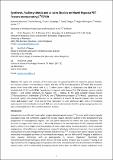Synthesis, radiosynthesis and in vitro studies on novel hypoxia PET tracers incorporating [18F]FDR
Abstract
We report the synthesis of five radiotracers incorporating different oxyamine spacers between the hypoxia‐reactive 2‐nitroimidazole moiety and the 5‐[18F]‐fluorodeoxyribose ([18F]FDR, 12 ) prosthetic group: three linear alkyl chains with 3, 5, 7 carbon atoms ( 15 a – c ), a cyclopropyl ring ( 15 d ) and a 1,4‐disubstituted‐1,2,3‐triazole ( 15 e ). Experiments in hypoxic cells showed that 15 d displays superior uptake kinetics – and similar selectivity for hypoxic cells – relative to the gold standard hypoxia tracers [18F]fluoroazomycin arabinoside ([18F]FAZA) and [18F]fluoromisonidazole ([18F]FMISO). Lipophilicity and structural rigidity have strong influence on the selectivity of tracers 15 towards hypoxic cells: the lead tracer 15 d displays a logP=0.38 and the most rigid spacer. A sixth radiotracer ( 15 f ), with a 2‐H‐imidazole replacing the 2‐nitroimidazole moiety of 15 d , was used to demonstrate that the cyclopropyl group does not play a meaningful role in the sensitivity towards hypoxia.
Citation
Zanda , M , Musolino , M , Fleming , I N , Schweiger , L F , O’Hagan , D & Dall’Angelo , S 2021 , ' Synthesis, radiosynthesis and in vitro studies on novel hypoxia PET tracers incorporating [ 18 F]FDR ' , European Journal of Organic Chemistry , vol. Early View . https://doi.org/10.1002/ejoc.202001670
Publication
European Journal of Organic Chemistry
Status
Peer reviewed
ISSN
1434-193XType
Journal article
Description
M.M. thanks SULSA for a PhD studentship. We gratefully acknowledge financial support from the EPSRC (grant EP/I034793/1).Collections
Items in the St Andrews Research Repository are protected by copyright, with all rights reserved, unless otherwise indicated.

